There are many yellow butterflies in the US. Yellow is sometimes the color butterflies take to improve camouflage as they feed on yellow flowers.
Most yellow butterflies feed on flowers and herbs of different colors.
The coloring of these native species ranges from pale yellow to dark yellow. Color combinations such as yellow and black or yellow and red are highly common among these butterflies.
Color differences between the sexes also exist with these butterflies. Some males can be yellow while females might have other colors.
Dorsal and ventral coloring may also differ from one species to another as well as between the sexes of the same species.
North America is home to permanent and migratory yellow butterflies. Almost all states (including Alaska) have a few types of yellow butterflies. Here are the most common species found on the North American continent.
Table of Contents
1. Orange Sulphur

Orange Sulphurs (Colias eurytheme) are part of a group known as Clouded Yellows which encompasses yellow butterflies of different species.
The color of these butterflies is variable. Both males and females can come in different colors.
Male Orange Sulphurs have a yellow dorsal with orange overlays or an orange ventral with yellow spots and yellow veins.
Females can be either yellow or white. Both males and females may also come with yellow ventral coloring.
This species is found in most US states.
You can find Orange Sulphur caterpillars on various flowers of the pea family.
Adults feed on nectar and there are high chances of spotting the butterflies around flowers such as dandelions and milkweeds.
2. Cloudless Sulphur

Cloudless Sulphurs (Phoebis sennae) are vividly-colored yellow butterflies native to the US.
Males have a brighter yellow color compared to females.
The male Cludless Sulphur has bright yellow coloring with visible yellow-green veins.
Females have dark yellow coloring with yellow dots and yellow margins.
Some of the yellow colorings on the male and female Cloudless Sulphur are also visible on the caterpillar of the species.
Cloudless Sulphur caterpillars have a green body with yellow lateral stripes and small blue dots in a morph.
However, the Cloudless Sulphur caterpillar can also be mostly yellow, especially when it only feeds on flowers.
When yellow is also the dominant color of the caterpillar, there are extra black stripes on its dorsum.
The Cloudless Sulphur is a versatile species when it comes to the nectar it can consume
It has longer tongues compared to other butterflies.
3. Sleepy Orange
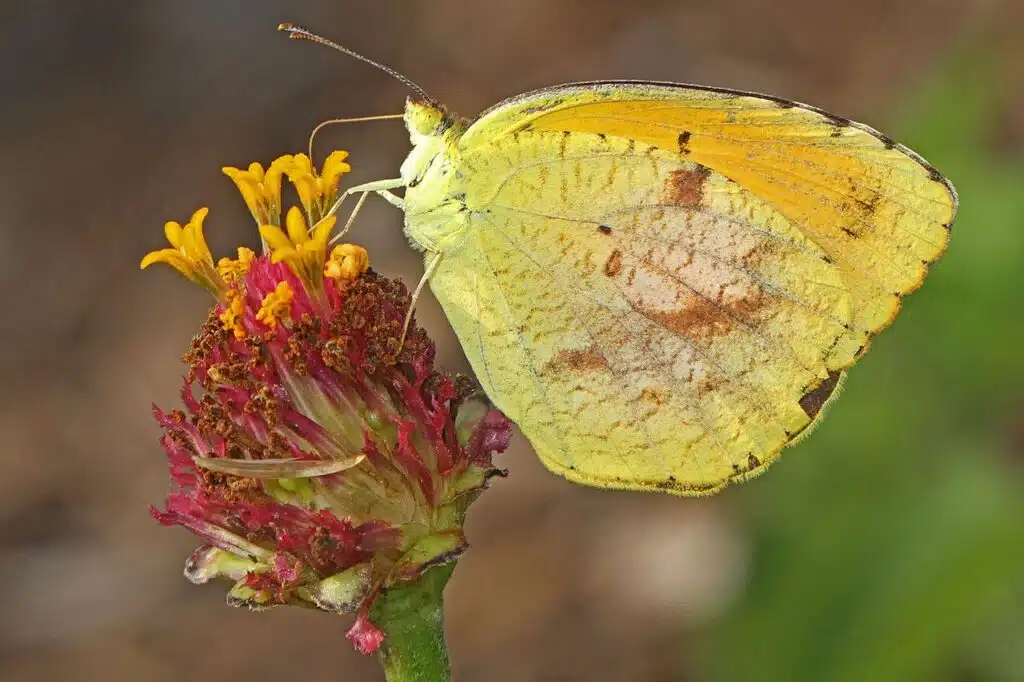
Sleepy Orange butterflies (Abaeis nicippe) are common in the US except for the Northern states.
This species comes in an orange color but yellow-orange coloring exists as well.
Yellow Sleepy Orange butterflies can be both male and female.
The species has a very linear lifecycle, comparable to the lifecycle of other yellow butterflies.
Caterpillars of the genus live on pea family species. Adults feed on nectar and they have a preference for Shepherd’s needle.
You can find this species in the summer when it prefers to live in a wide lowland range. You can find this species in the summer when it prefers to live in a wide lowland range.
Pine flats are among its favorites. The species is also highly common in urban areas, especially in parks and gardens.
4. Dainty Sulphur
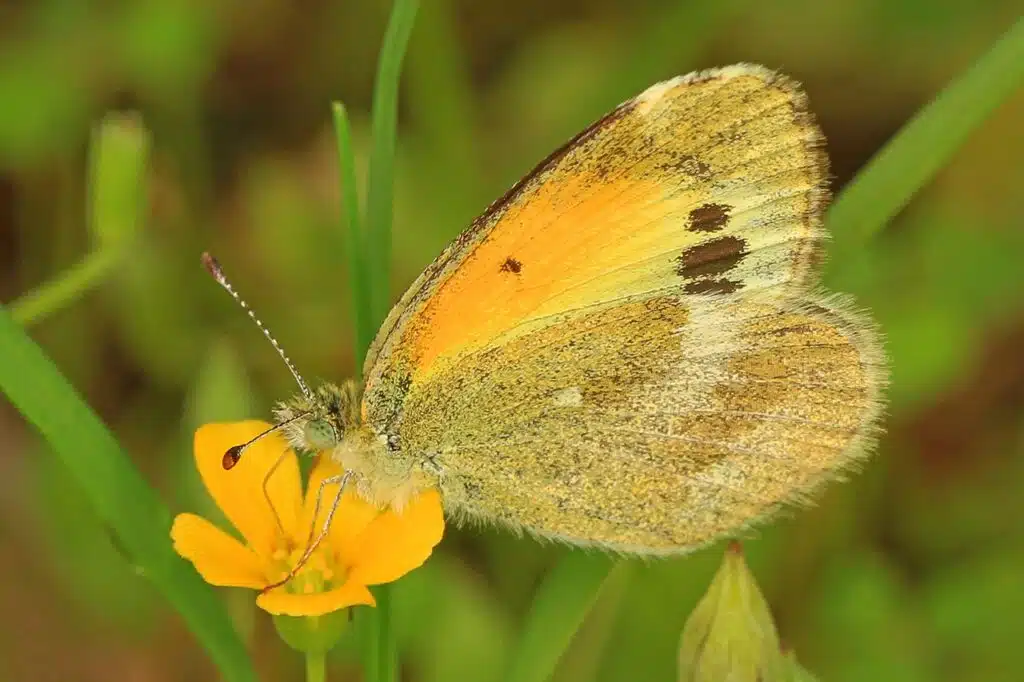
Dainty Sulphurs (Nathalis iole) are some of the most common yellow butterflies in the US. They live in all states but have different flight seasons depending on temperature.
Dainty Sulphur butterflies are active around the year in states such as Florida where they like the warm weather.
These butterflies may only be active for up to 6 months in states such as Ohio or Montana.
Male Dainty Sulphurs have a yellow body with narrow black lines. Female Dainty Sulphurs have similar yellow coloring. Small differences still exist between males and females.
The black sections on the females are wider.
You may also find white male and female Dainty Sulphurs, but these examples are rare.
The species prefers to live on short vegetation and feed on flowers such as asters. Wild marigolds and other short wildflowers might also attract Dainty Sulfur butterflies.
5. Eastern Tiger Swallowtail

Eastern Tiger Swallowtails (Papilio glaucus) are present in numerous Southeastern states.
The species grows up to a wingspan of 5.5 inches.
Unlike Dainty Sulphurs, the Eastern Tiger Swallowtail is a species known for flying at higher altitudes.
These butterflies are often seen flying above trees.
The species gets its name from its black tiger-like stripes seen on the male, but not on the female.
Males are yellow and black while females come at least in 2 other colors. Females have blue stripes but they are more common in a dark brown color rather than the light yellow of the males.
This highly contrasting nature of the male makes it more common than the female which is larger.
Butterflies of the species are the official state mascot of Alabama.
6. Western Tiger Swallowtail

The Western Tiger Swallowtail (Papilio rutulus) is a similar species to the Tiger Swallowtail that lives on the Western Coast of North America.
Its range expands from California to British Columbia.
This species also has black and yellow coloring. The nuances of yellow are somewhat distinct and can vary from one region to another.
You can quickly see the species from its caterpillar stage as it lives on common poplar trees.
Adults are found next to woodlands and especially next to water sources. You can find Western Tiger Swallowtails next to streams and rivers.
As adults, the Western Tiger Swallowtail doesn’t eat hardwood tree leaves. It prefers nectar from species such as thistle.
7. Clouded Sulphur

Clouded Sulphur butterflies (Colias philodice) are some of the common species with a widespread North American distribution.
These butterflies are adapted to living in all areas from Southern Texas to Alaska.
Both males and females are yellow, with small coloring and pattern differences.
Males are yellow-green with yellow fringes. Females are lemon-yellow with black and red fringing. 2 orange spots are also seen on the dorsal of the female.
Like many species that live both in the US and Canada, adult Clouded Sulphurs feed on alfalfa as well as other plants such as milkweed and dandelion.
Some morphs of this species might also be found on occasion given the Clouded Sulphur lives in a wide range of territories.
This butterfly is mostly found in yellow color but some areas of the country also host white male Clouded Sulphurs.
8. Little Yellow
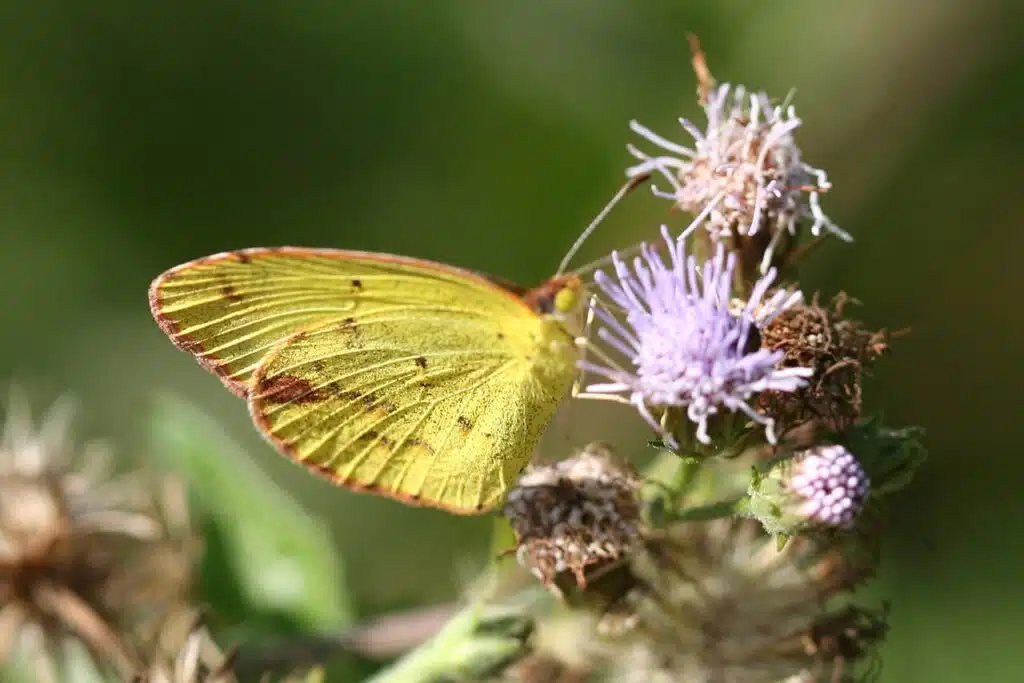
Both males and females of the Little Yellow species (Pyrisitia lisa) are yellow.
These butterflies may also be white, but this morph is very rare.
You can find Little Yellow butterflies across the Southeastern parts of the US and in Eastern states.
Little Yellow butterflies prefer open drained areas for their typical habitat.
This species has multiple flight seasons and are considered small compared to other yellow butterflies as they have a wingspan of around 1 inch.
Little Yellow butterflies live in multiple habitats where partridge peas grow as they lay eggs on this species.
Like many butterflies, eating preferences change as the Little Yellow becomes an adult. Asters are among the favorite source of nectar for Little Yellow adults.
9. Southern Dogface

Southern Dogface butterflies (Zerene cesonia) have yellow dorsal coloring and yellow ventral coloring.
Butterflies of this species have mostly yellow coloring with black wing margins. The butterflies also have yellow coloring with pink or red margins in the case of females.
Light yellow colors are also specific to the ventral side of the species.
Adult Southern Dogface butterflies lay eggs on the underside of leaves. Multiple eggs are laid at once on the underside of leaves, particularly on leaves of a pea species plant.
Alfalfa and verbena nectar are among the preferred nectar sources for adult feeding.
Southern Dogface butterflies are also common all around the world. Apart from being found in most US states, Southern Dogface butterflies are also found in South America.
10. Canadian Tiger Swallowtail

Canadian Tiger Swallowtails (Papilio canadensis) are a common sight across Canada and parts of the Northern US. This species is very similar to US Tiger Swallowtail.
The size of the species is the main difference between the Canadian Swallowtail and other swallowtail species.
The Canadian subspecies have a slightly shorter wingspan.
Yellow and black coloring is still specific to the male Canadian Swallowtail.
This species is known for puddling. This is a behavior where butterflies gather in groups in moist areas or when they find food such as carrion.
As a result, the best time to see Canadian Tiger Swallowtails is when they puddle either for water or for food.
11. Large Orange Sulphur
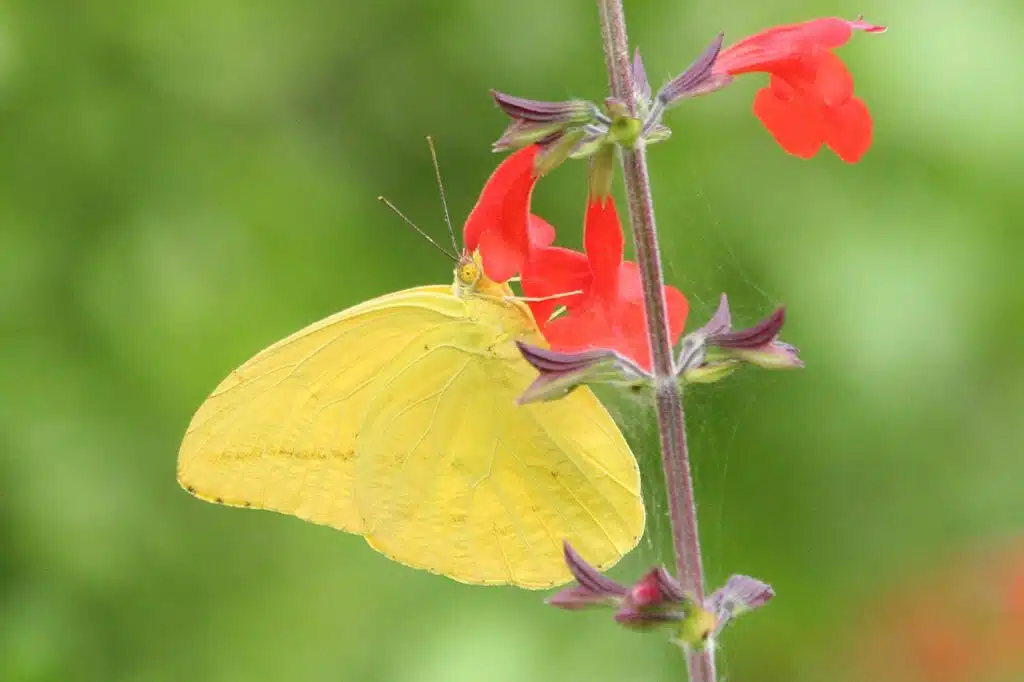
Large Orange Sulphurs (Phoebis agarithe) come in different colors. The male is mostly orange, as the name implies.
Female Large Orange Sulphurs can be yellow and different from the dark orange color of males.
Some females might even be yellow-orange, but never truly orange as males.
This species is found in scattered locations across the US, mostly in the South.
It has a green caterpillar that eats the leaves of pea family plants.
Adults feed on a wide range of flowers. They consume nectar.
Most adults feed on the nectar of Shepherds’ needle or hibiscus flowers. They might also feed on various flowers of the rose family.
12. Orange-barred Sulphur

Orange-barred Sulphur butterflies (Phoebis philea) have a common wingspan that measures anywhere between 60 and 80mm.
This species is known for its almost uniform yellow coloring.
Its yellow colors help the species remain undetected as many see it as a leaf, especially when standing still.
Male and female Orange-barred Sulphur butterflies are common on red flowers. They only eat the nectar from red flowers.
The larvae of these yellow butterflies feed on the leaves of trees and not on red flowers. It prefers to consume the leaves of various cassia.
These butterflies are often seen easily as they do not live solitary lives like other species. They prefer to live in the proximity of other butterflies, even if these are of other species.
13. Mexican Yellow
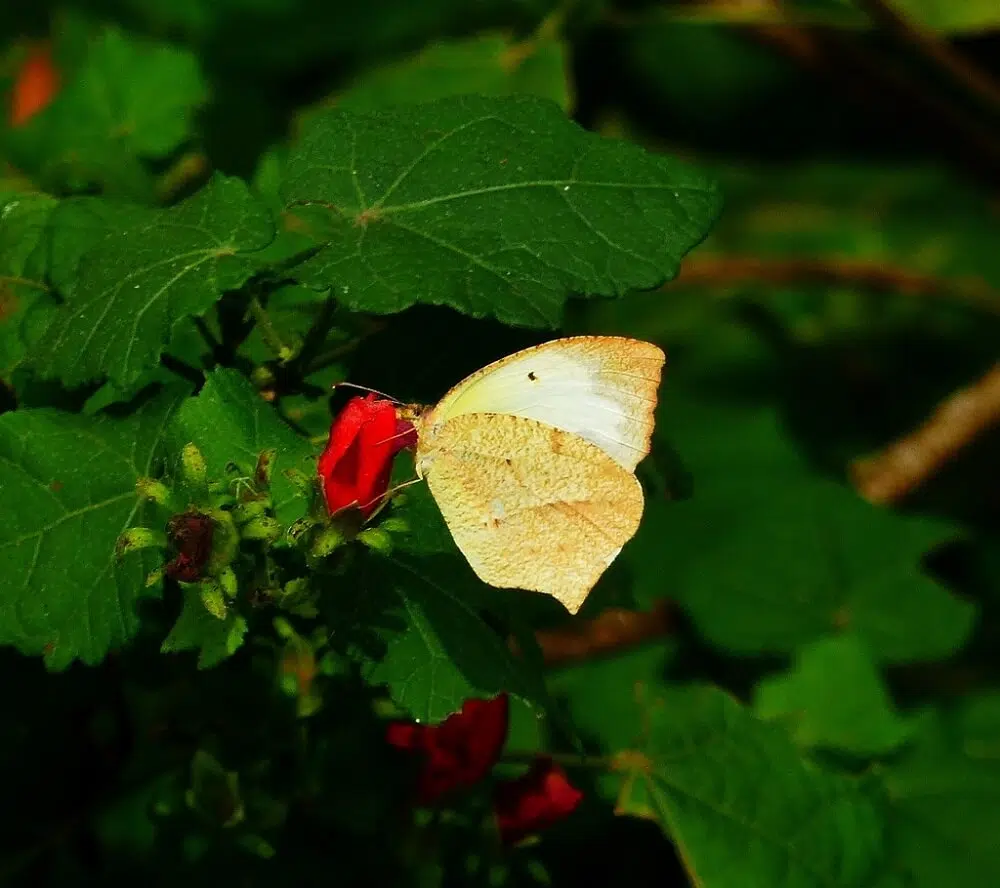
Mexican Yellow (Abaeis Mexicana) is a type of common yellow butterfly that like to live in arid climates, among other habitats.
Males have light yellow upper wings and dark yellow hindwings while females only have light yellow wings.
Both males and females have black margins around the wings.
These species can appear almost white at times as their yellow is lemon yellow unlike the crude yellow of the Orange Barred-Sulphur.
These butterflies live in woodlands and open woodlands. They also live in deserts that have sufficient vegetation for them to feed on and lay eggs on.
Butterflies of this genus mostly feed on white flowers such as the New Mexico Locust.
They also feed on ferns and various cassia species similar to the Orange Barred-Sulphur.
14. Tailed Orange

Tailed Orange butterflies (Pyrisitia proterpia) are used to living in harsh desert climates. The species is seen across Texas, Arizona, and parts of Northern Mexico.
The dorsal side of the species is orange while its ventral side is yellow. Butterflies of this genus grow to a size that’s slightly larger than the average.
It reaches a wingspan of up to 2 inches.
Highly common in Texas and seen all year in tropical climates, the caterpillar of the species feeds on mesquite.
Adult Tailed Orange butterflies feed on flower nectar.
While it lives in very dry conditions, the species is not threatened by a constant population also attributed to a low number of natural predators.
15. Pink-edged Sulphur
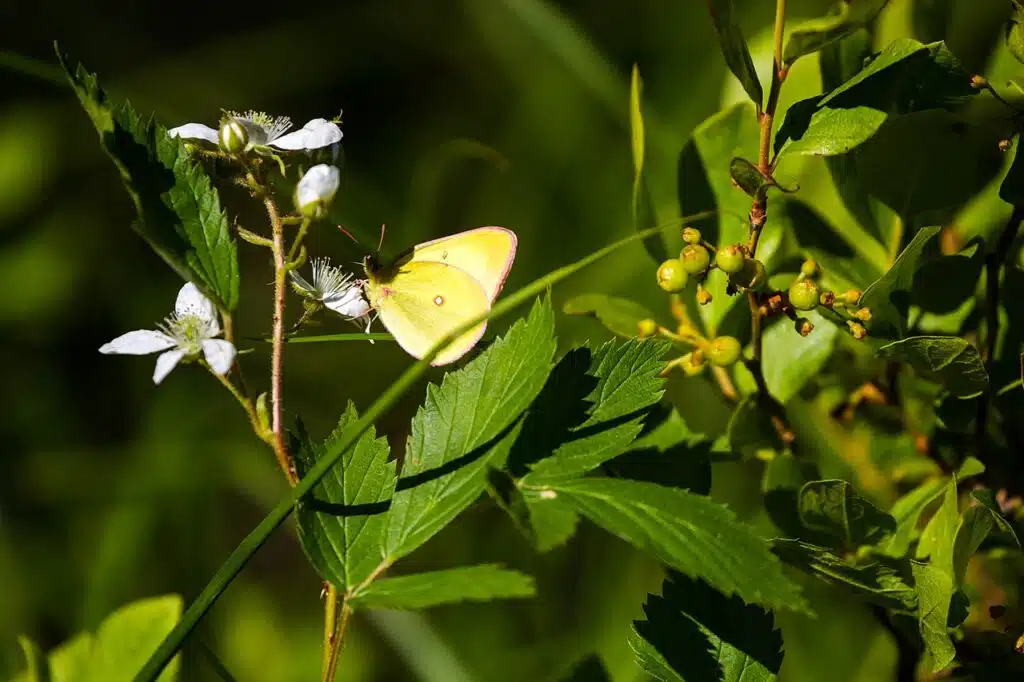
Pinked-edged Sulphurs (Colias interior) live in Southern Canada and parts of the Northern US.
These butterflies are known for their green-yellow colors in the case of males and yellow color in the case of females.
Growing to a size of up to 66mm, these butterflies can have a longer wingspan compared to other species. However, many Pink-edged Sulphur butterflies measure just above 30mm.
You can find many female Pink-edged Sulphurs around blueberries that grow at higher altitudes in Canada and the US.
Female Pink-edged Sulphurs don’t eat blueberries as they only lay eggs on them.
Asters are among the favorite flowers for adults to eat. Bristly sarsaparillas are also among their favorites.
16. Mimosa Yellow

Mimosa Yellow butterflies (Pyrisitia nise) have an almost uniform yellow color. Both males and females have a bright yellow color with only a couple of black spots on the wings.
This species has a scattered presence. The states that have the highest populations of Mimosa Yellow are the Southern states.
The size of Mimosa Yellows differs considerably, mainly upon food availability. These butterflies can have a wingspan of 1 inch or a wingspan of 2 inches between broods, even in the same habitat.
Smaller and stills scattered populations of Mimosa Yellow are further found across Colorado and Kansas.
Mimosa Sensitive plants in the family of peas are the host of this species as its name implies.
Adults feed on a wide range of flowers.
17. Statira Sulphur

The Statira Sulphur species (Aphrissa statira) has bright yellow coloring. Females have even brighter yellow colors compared to males.
Satira Sulphurs are among the species that feed on coinvine as caterpillars. The caterpillars of the species have some of the most damaging roles to this plant as they invade in high numbers.
Adults feed on flower nectar, particularly on the nectar of certain red flowers.
Common in Southern US habitats, this species thrives in tropical climates.
Statira Sulphur is also among the species that migrate every year. Wet and dry seasons allow the species to migrate towards the ocean or upriver.
Some Statira Sulphurs are very good at flying over long distances and settling in remote warm tropical islands such as in the Antileas.
18. Harford’s Sulphur

Common in regions of California, the species (Colias harfordii) is known for its pale yellow color.
Its wings can be uniform yellow or have pink or red margins. These wings might also have red eye-like circles on the females.
Chaparral and woodlands are among the favorite habitats of the species.
Harford’s Sulphurs cannot travel far from these places as they have very specific feeding requirements.
For example, the caterpillars of the species feed on Douglas’s milkvetch. They overwinter on this plant as eggs before emerging in the spring as caterpillars.
It can take up to 6-8 weeks for the species to go through its all caterpillar instars.
Some of the herbs growing around woodlands keep the adults in the areas after pupation. Mint is one of the herbs that attract the species.
19. Boisduval’s Yellow

Common in Southern states such as Texas, Boisduval’s Yellow (Abaeis boisduvaliana) is dominated by yellow coloring with a few different morphs that are all yellow.
This species starts life as a green caterpillar.
Yellow lateral stripes are seen on this green caterpillar.
The species that becomes yellow as an adult. It only feeds on the nectar of yellow flowers, which explains its camouflage yellow coloring.
The male of the species has yellow wings with black margins. Its ventral side is uniformly yellow. The female of the species is also yellow.
Females have yellow wings with red-brown marks.
The ventral side of the female is either yellow-green or red and yellow.
Both males and females look like yellow leaves when their wings are closed.
20. Dina Yellow
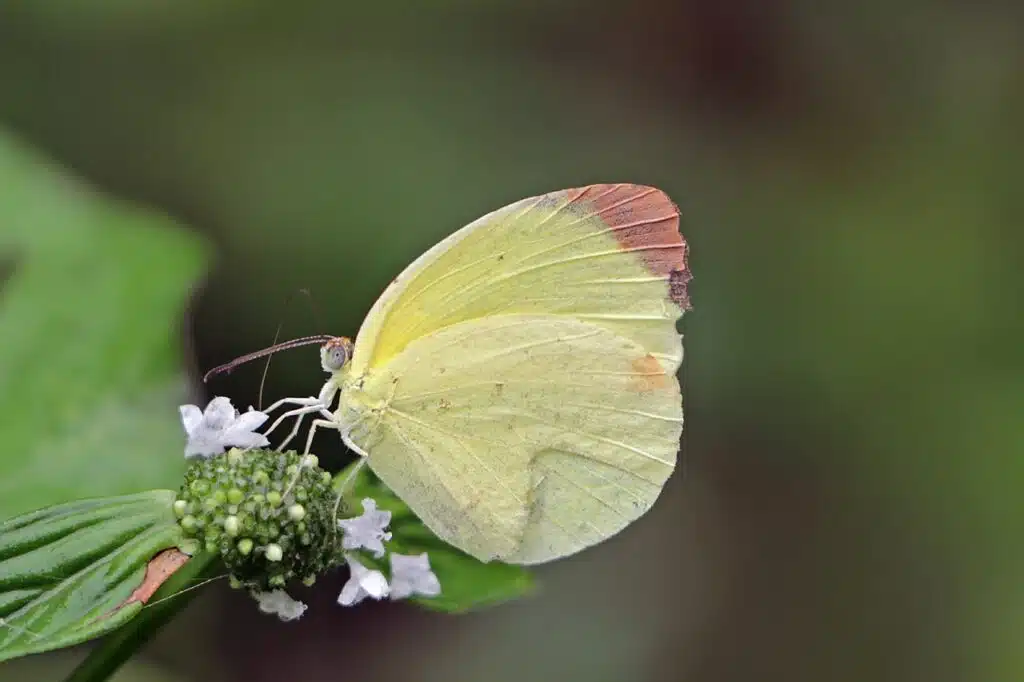
This species (Pyrisitia dina) is only found in the Southern regions of New Mexico, Arizona, Texas, and Florida. It has a widespread presence in Cuba and Puerto Rico.
Male Dina Yellows have an orange-yellow color with or without margins. Females are mostly yellow.
The species has a wingspan that can measure anywhere between 1 and 2 inches.
Caterpillars of the species are mostly seen feeding on Mexican alvaradoa while adults feed on lantanas and asters.
The species is most abundant on forest edges.
However, its diet differs from the areas it lives on as it can be found across very remote tropical locations.
21. Western Sulphur
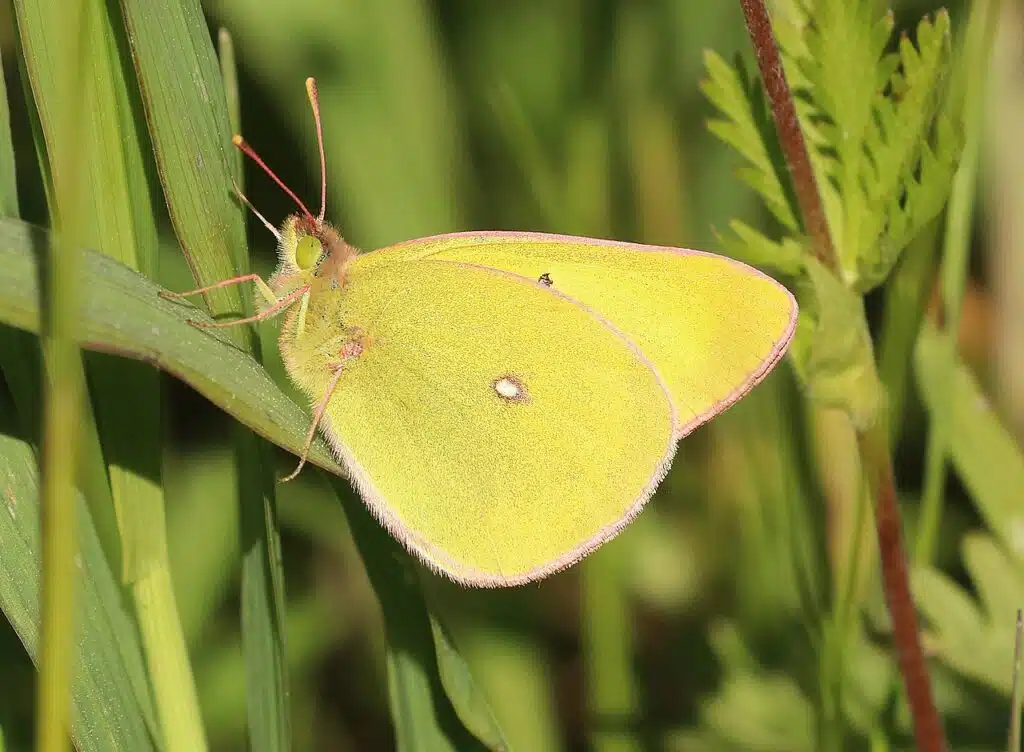
Western Sulphurs (Colias occidentalis) are common in Southern Canada and Northwestern US states.
This species has a dark yellow color without margins. Small pink and red dots are seen on the wings.
While the conditions in these areas of the US and Canada rarely change, this species has small size fluctuations.
Its wingspan ranges between 50 and 53mm.
Sometimes living at high altitudes and other times living next to the ocean, this species feeds both on herbs and on wildflowers.
Lupines and vetches are among its favorites.
22. Yellow Angled-Sulphur

Yellow Angled-Sulphur butterflies (Anteos maerula) are some of the largest yellow butterflies found in the US. This species lives in tropical climates but it’s also present in Florida and parts of Texas.
The species is migratory and may be found in some US states in the warmest months of the summer before heading back to warmer regions.
Yellow Angle-Sulphurs have a wingspan that measures at least 3 inches and which can sometimes measure more than 4 inches.
Adults of the species feed on common flowers of red and purple coloring. They are attracted to these colors more than others.
The Yellow Angled-Sulphur caterpillar feeds on more common types of food, also shared with other caterpillars.
These caterpillars on cassia and pea family plants.
23. Moorland Clouded Yellow

The Moorland Clouded Yellow (Colias palaeno) is one of the yellow species with the widest global distribution.
This species is native to the US, Europe, and Asia.
It lives in forests and open land with plenty of vegetation. Its adaptation to temperate climates allows it to have an extensive range.
This species has yellow or yellow-green coloring.
Its wings are yellow with wide black margins. The female has a similar yellow color with narrower yellow margins.
The ventral side of the species looks very similar to its dorsal side, apart from the black margins both in males and females.
Growing to a maximum size of 50mm, this species is dominated by a yellow-green color in all of its other rare morphs.
24. Two-tailed Swallowtail

The Two-tailed Swallowtail (Papilio multicaudata) is a native species to Western US habitats. It lives in valleys and canyons where it gets protected from extreme weather.
This species is active from May in most states.
You can identify it by its yellow coloring with black lines all across its wings.
The species also has 2 long tails that inspire its name.
An ideal place to find the species is to look for ash trees in valleys across Western North America. It’s here that the caterpillars grow and pupate feeding on ash leaves.
Adults feed on nectar, particularly from species such as lilac and thistles, highly common on The West Coast.
25. Edwards’s Fritillary
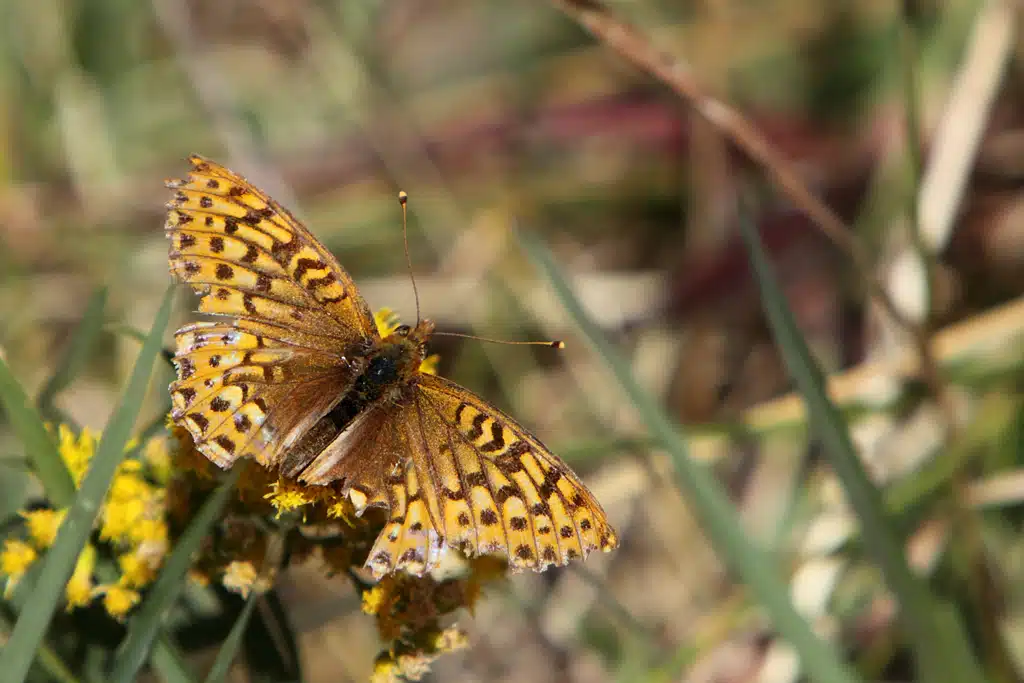
This species (Speyeria edwardsii) is only yellow on the ventral side. It has yellow and silver coloring on the underside while the dorsal is brown and orange colored.
It has a very widespread North American distribution across the US and into Canada.
The species is larger than other multicolored yellow butterflies as it can have a wingspan of up to 86mm.
One of the reasons this species has yellow ventral wings is its ability to remain undetected on yellow flowers with its closed wings.
Naturally attracted to yellow flowers, Edwards’s Fritillary is a species that mostly feeds on the nectar of yellow flowers such as the Yellow prairie violet.
26. Silver-banded Hairstreak

This species (Chlorostrymon simaethis) has yellow-green underside coloring. The yellow nuance of the wings is similar to the yellow-green nuance of its host plants.
Female Silver-banded Hairstreak produce almost completely green eggs which are laid directly in fruits.
These eggs develop into a caterpillar that feeds on fruit.
Silver-banded Hairstreaks don’t have any yellow spots or stripes. They are almost completely green.
This species is known to have 2 to 3 broods per year.
27. Queen Alexandra’s Sulphur

Queen Alexandra’s Sulphurs (Colias alexandra) have yellow coloring both on the dorsal and ventral sides.
The species is green-dominant on the dorsal. Males have yellow spots close to the body while females have larger yellow spots.
Male Queen Alexandra’s Sulpurs are mostly gray to silver ventrally. Females have light yellow ventral coloring.
The species is seen all across North America and around the world. They feed on the nectar of various fruit trees, legumes, and flowers.
False lupines are among the favorite sources of nectar for Queen Alexandra’s Sulphurs. These are a type of legumes.
The species also feeds on Peavine nectar.
28. Lyside Sulphur

This rare species (Kricogonia lyside) is only found in a few remote areas of the US. Most Lyside SUlphurs in the US live in Texas and Arizona. Smaller populations exist in Florida.
It’s in Texas that this species has a year-round flight season. It flies to tale fall in Arizona and Florida.
Lyside Sulphurs are subject to large migratory habits if they live in an environment where temperatures go down in winter.
Lyside Sulphurs look highly similar to Queen Alexandra’s Sulphur. Major differences include a more pronounced yellow nuance as opposed to the yellow-green base nuance of the similar Queen Alexandra’s Sulphurs.
Further Reading: